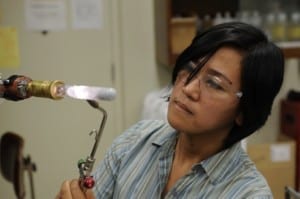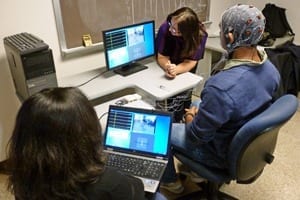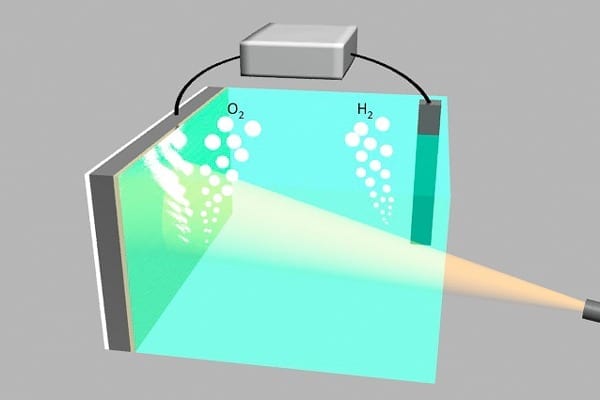
Quite by accident, Washington State University researchers have achieved a 400-fold increase in the electrical conductivity of a crystal simply by exposing it to light.
The effect, which lasted for days after the light was turned off, could dramatically improve the performance of devices like computer chips.
WSU doctoral student Marianne Tarun chanced upon the discovery when she noticed that the conductivity of some strontium titanate shot up after it was left out one day. At first, she and her fellow researchers thought the sample was contaminated, but a series of experiments showed the effect was from light.
“It came by accident,” said Tarun. “It’s not something we expected. That makes it very exciting to share.”
The phenomenon they witnessed—“persistent photoconductivity”—is a far cry from superconductivity, the complete lack of electrical resistance pursued by other physicists, usually using temperatures near absolute zero. But the fact that they’ve achieved this at room temperature makes the phenomenon more immediately practical.
And while other researchers have created persistent photoconductivity in other materials, this is the most dramatic display of the phenomenon.
The research, which was funded by the National Science Foundation, appears this month in the journal Physical Review Letters.
“The discovery of this effect at room temperature opens up new possibilities for practical devices,” said Matthew McCluskey, co-author of the paper and chair of WSU’s physics department. “In standard computer memory, information is stored on the surface of a computer chip or hard drive. A device using persistent photoconductivity, however, could store information throughout the entire volume of a crystal.”
This approach, called holographic memory, “could lead to huge increases in information capacity,” McCluskey said.
Strontium titanate and other oxides, which contain oxygen and two or more other elements, often display a dizzying variety of electronic phenomena, from the high resistance used for insulation to superconductivity’s lack of resistance.
“These diverse properties provide a fascinating playground for scientists but applications so far have been limited,” said McCluskey.
Go deeper with Bing News on:
Persistent photoconductivity
- Persistent Systems Ltd
We sell different types of products and services to both investment professionals and individual investors. These products and services are usually sold through license agreements or subscriptions ...
- The SMB’s Guide to Advanced Persistent Threats
If you think your sensitive data is safe behind anti-malware software, think again. Advanced persistent threats stealthily breach your defenses and settle in for the long haul. You know you should ...
- Persistent clouds kept temperatures cool
MYRTLE BEACH, S.C. (WBTW) — Overcast conditions were felt throughout the morning leading to temperatures more than 10 degrees cooler than lunchtime yesterday. Temperatures were only in the upper ...
- The Market News Today: Persistent PCE Inflation Pressures Loom in March
The Federal Reserve’s preferred inflation gauge, the Personal Consumption Expenditures (PCE) index, likely remained high in March, suggesting persistent price pressures. Forecasters anticipate a ...
- Persistent Systems Q4 Results Live : profit rise by 25.37% YOY
Persistent Systems Q4 Results Live : Persistent Systems declared their Q4 results on 22 Apr, 2024. The topline increased by 14.91% & the profit increased by 25.37% YoY. Compared to the previous ...
Go deeper with Google Headlines on:
Persistent photoconductivity
[google_news title=”” keyword=”Persistent photoconductivity” num_posts=”5″ blurb_length=”0″ show_thumb=”left”]
Go deeper with Bing News on:
Holographic memory
- The science behind memory
Kensinger points out some surprising facts about how memories work Explaining the science behind memory and memory loss—including why forgetting is a crucial property of memory, as well as strategies ...
- Assisted Living vs. Memory Care: What’s the Difference?
The challenge becomes finding the right “new home,” especially if your elderly parent or spouse is experiencing memory problems. “It’s vital to really look at the support needs and ...
- Did Stanford just prototype the future of AR glasses?
A research team at Stanford is developing a new AI-assisted holographic imaging technology it claims is thinner, lighter, and higher quality than anything its researchers have seen. Could it take ...
- Team observes two distinct holographic patterns with ultrafast imaging
Lai at the Innovation Academy for Precision Measurement Science and Technology has achieved a breakthrough in ultrafast imaging by separately and clearly observing two distinct holographic ...
- Best RAM in 2024
Whether you’re purchasing or upgrading a gaming PC or everyday workstation, the component that you need to handle multiple tasks is RAM, or read-only memory. It can be quite confusing ...
Go deeper with Google Headlines on:
Holographic memory
[google_news title=”” keyword=”holographic memory” num_posts=”5″ blurb_length=”0″ show_thumb=”left”]










